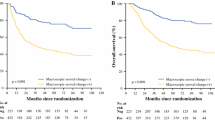Abstract
Background
Accurate intraoperative diagnosis of serosal invasion is a prerequisite for proper application of invasive procedures, such as intraperitoneal chemohyperthermia, for serosa positive gastric carcinomas.
Methods
We reviewed the prospectively constructed data of 1,265 gastric cancer patients who underwent surgery between 2007 and 2009. Accuracies of macroscopic diagnoses of serosal invasion were determined by comparing with pathological findings. The risk factors of over- and underestimation of serosal invasion were analyzed in the univariate and multivariate model.
Results
The accuracy of macroscopic intraoperative diagnosis of serosal invasion was 88%. Serosal invasion was underestimated in 34 of 187 serosa positive patients and overestimated in 117 of 1,078 serosa negative patients; a sensitivity and specificity of 82 and 89%, respectively. When pT1 tumors were excluded, the accuracy, sensitivity, and specificity of macroscopic diagnosis of serosal invasion were 71.5, 81.8, and 65.3%, respectively. Univariate and multivariate analysis revealed that a tumor size of >4 cm and preoperative CT finding of serosa positive were independent risk factors for macroscopic overestimation as serosal invasion in pT2 gastric cancer. Meanwhile, Borrmann type 1, preoperative CT finding of serosa negative, lesser/posterior surface location, and tumor size of <4 cm were independent risk factors for underestimation of serosal invasion in pT3 gastric carcinoma.
Conclusions
The macroscopic diagnosis of serosal invasion is largely consistent with pathological findings. However, great care should be taken with regard to the risk of over- and underestimation of serosal invasion when making a decision for invasive treatments based on macroscopic findings of serosal invasion.
Similar content being viewed by others
References
Nio Y, Tsubono M, Kawabata K et al (1993) Comparison of survival curves of gastric cancer patients after surgery according to the UICC stage classification and the General Rules for Gastric Cancer Study by the Japanese Research Society for gastric cancer. Ann Surg 218:47–53
Zhang XF, Huang CM, Lu HS et al (2004) Surgical treatment and prognosis of gastric cancer in 2,613 patients. World J Gastroenterol 10:3405–3408
Yoo CH, Noh SH, Shin DW et al (2000) Recurrence following curative resection for gastric carcinoma. Br J Surg 87:236–242
Yonemura Y, Ninomiya I, Kaji M et al (1995) Prophylaxis with intraoperative chemohyperthermia against peritoneal recurrence of serosal invasion-positive gastric cancer. World J Surg 19:450–454. doi:10.1007/BF00299188 (discussion 455)
Yu W, Whang I, Suh I et al (1998) Prospective randomized trial of early postoperative intraperitoneal chemotherapy as an adjuvant to resectable gastric cancer. Ann Surg 228:347–354
Yu W, Whang I, Averbach A et al (1998) Morbidity and mortality of early postoperative intraperitoneal chemotherapy as adjuvant therapy for gastric cancer. Am Surg 64:1104–1108
Japanese Gastric Cancer Association (1998) Japanese classification of gastric carcinoma, 2nd English Edition. Gastric Cancer 1:10–24
Sobin LH, Witteking Ch (eds) (2002) International union against cancer TNM classification of malignant tumors, 6th edn. Wiley-Liss, New York
Ichiyoshi Y, Maehara Y, Tomisaki S et al (1995) Macroscopic intraoperative diagnosis of serosal invasion and clinical outcome of gastric cancer: risk of underestimation. J Surg Oncol 59:255–260
Korenaga D, Okuyama T, Orita H et al (1994) Role of intraoperative assessment of lymph node metastasis and serosal invasion in patients with gastric cancer. J Surg Oncol 55:250–254
Kodera Y, Yamamura Y, Shimizu Y et al (1999) Peritoneal washing cytology: prognostic value of positive findings in patients with gastric carcinoma undergoing a potentially curative resection. J Surg Oncol 72:60–64 (discussion 64–65)
Yan TD, Black D, Sugarbaker PH et al (2007) A systematic review and meta-analysis of the randomized controlled trials on adjuvant intraperitoneal chemotherapy for resectable gastric cancer. Ann Surg Oncol 14:2702–2713
Yu W, Whang I, Chung HY et al (2001) Indications for early postoperative intraperitoneal chemotherapy of advanced gastric cancer: results of a prospective randomized trial. World J Surg 25:985–990. doi:10.1007/s00268-001-0067-7
Lee SE, Ryu KW, Nam BH et al (2009) Prognostic significance of intraoperatively estimated surgical stage in curatively resected gastric cancer patients. J Am Coll Surg. 209:461–467
Yasuda K, Shiraishi N, Inomata M et al (2007) Prognostic significance of macroscopic serosal invasion in advanced gastric cancer. Hepatogastroenterology 54:2028–2031
Kwee RM, Kwee TC (2007) Imaging in local staging of gastric cancer: a systematic review. J Clin Oncol 25:2107–2116
Fujimoto T, Zhang B, Minami S et al (2002) Evaluation of intraoperative intraperitoneal cytology for advanced gastric carcinoma. Oncology 62:201–208
Yu W, Choi GS, Chung HY (2006) Randomized clinical trial of splenectomy versus splenic preservation in patients with proximal gastric cancer. Br J Surg 93:559–563
Kim JH, Kang SH, Oh ST et al (2009) Following of the omentum preserving gastrectomy for advanced gastric cancer without serosa exposure. J Korean Surg Soc 76:154–158
Acknowledgments
This work was supported by a grant (CRI 11-066-1) from the Chonnam National University Hospital Research Institute of Clinical Medicine.
Conflicts of interest
None.
Author information
Authors and Affiliations
Corresponding author
Rights and permissions
About this article
Cite this article
Jeong, O., Ryu, S.Y., Jeong, M.R. et al. Accuracy of Macroscopic Intraoperative Diagnosis of Serosal Invasion and Risk of Over- and Underestimation in Gastric Carcinoma. World J Surg 35, 2252–2258 (2011). https://doi.org/10.1007/s00268-011-1197-1
Published:
Issue Date:
DOI: https://doi.org/10.1007/s00268-011-1197-1




